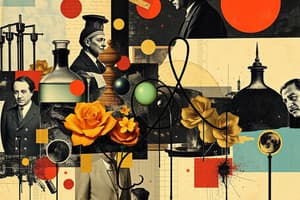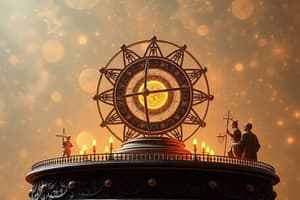Podcast
Questions and Answers
What did Democritus propose about matter?
What did Democritus propose about matter?
- Matter is composed of small, indivisible particles called 'atomos'. (correct)
- Matter is continuous and infinitely divisible.
- Matter does not consist of atoms, but rather of continuous waves.
- All matter is made up of four elements: earth, water, air, and fire.
Which statement accurately reflects Dalton's atomic theory?
Which statement accurately reflects Dalton's atomic theory?
- Atoms can be divided into smaller components.
- Compounds are formed by combining different atoms in fixed ratios. (correct)
- Atoms of different elements can have identical masses.
- Chemical reactions involve the formation of new atoms.
What significant discovery did Thomson make in 1897?
What significant discovery did Thomson make in 1897?
- The existence of the neutron.
- The nucleus of the atom.
- The concept of quantized energy levels.
- The electron using cathode ray experiments. (correct)
What was revealed by Rutherford's gold foil experiment?
What was revealed by Rutherford's gold foil experiment?
Which concept did Bohr introduce regarding electron movement?
Which concept did Bohr introduce regarding electron movement?
What distinguishes the Quantum Mechanical Model from Bohr's Model?
What distinguishes the Quantum Mechanical Model from Bohr's Model?
What components make up an atom according to modern atomic theory?
What components make up an atom according to modern atomic theory?
Which of the following best represents the evolution of atomic theory?
Which of the following best represents the evolution of atomic theory?
Flashcards are hidden until you start studying
Study Notes
History of the Atomic Model
-
Early Theories
- Democritus (5th century BCE): Proposed that matter is composed of small, indivisible particles called "atomos."
- Aristotle (4th century BCE): Rejected atomic theory; believed matter was continuous (earth, water, air, fire).
-
Dalton's Atomic Theory (1803)
- Proposed that elements are made of atoms.
- Atoms of a given element are identical in mass and properties.
- Compounds formed by combining different atoms in fixed ratios.
- Chemical reactions involve the rearrangement of atoms.
-
Thomson's Model (1897)
- Discovered the electron using cathode ray experiments.
- Proposed the "plum pudding model," where electrons are embedded in a positively charged "soup."
-
Rutherford's Model (1911)
- Conducted the gold foil experiment, revealing a small, dense nucleus at the center of the atom.
- Proposed that most of the atom is empty space, with electrons orbiting the nucleus.
-
Bohr's Model (1913)
- Introduced quantized orbits for electrons around the nucleus.
- Proposed that electrons move in fixed paths (orbits) with specific energy levels.
-
Quantum Mechanical Model (1920s)
- Developed by Schrödinger and others.
- Electrons are described by wave functions and exist in probabilistic clouds (orbitals) rather than fixed paths.
- Introduces the concept of electron spin and the uncertainty principle.
-
Modern Atomic Theory
- Atoms consist of protons, neutrons, and electrons.
- Protons and neutrons reside in the nucleus, while electrons occupy orbitals around it.
- The atomic number defines the element, while mass number relates to the total number of protons and neutrons.
Key Developments
- Transition from solid indivisible particles (Democritus) to complex quantum models.
- Evolution from simple theories (Dalton) to sophisticated understanding (Quantum mechanics).
- The role of experiments (Thomson, Rutherford) in shaping atomic theory.
Conclusion
The atomic model has evolved significantly over time, reflecting advancements in scientific understanding and experimental techniques, leading to the current quantum mechanical view of the atom.
Early Theories
- Democritus (5th century BCE) proposed that matter is composed of small, indivisible particles termed "atomos."
- Aristotle (4th century BCE) dismissed atomic theory, asserting that matter is continuous, consisting of the four classical elements: earth, water, air, and fire.
Dalton's Atomic Theory (1803)
- Elements are made of indivisible atoms.
- Atoms of a specific element share identical mass and properties.
- Compounds are formed by combining different atoms in fixed ratios.
- Chemical reactions involve the rearrangement of atoms.
Thomson's Model (1897)
- Discovered the electron through cathode ray tube experiments.
- Introduced the "plum pudding model," depicting electrons embedded in a positively charged medium.
Rutherford's Model (1911)
- Conducted the gold foil experiment, discovering a small, dense nucleus at the atom's center.
- Proposed that most of the atom consists of empty space, with electrons in orbit around the nucleus.
Bohr's Model (1913)
- Introduced quantized orbits for electrons around the nucleus.
- Proposed that electrons follow fixed paths (orbits) corresponding to specific energy levels.
Quantum Mechanical Model (1920s)
- Developed by Schrödinger and others, marking a shift from fixed paths to probabilistic electron behaviors.
- Electrons are described by wave functions and exist in probability distributions (orbitals).
- Introduces concepts of electron spin and the uncertainty principle, highlighting limits on measuring certain properties.
Modern Atomic Theory
- Atoms are comprised of protons, neutrons, and electrons.
- Protons and neutrons reside in the nucleus, while electrons occupy surrounding orbitals.
- The atomic number identifies the element, while the mass number indicates the total count of protons and neutrons.
Key Developments
- Shift from the notion of solid, indivisible particles (Democritus) to complex quantum models.
- Progression from elementary atomic ideas (Dalton) to intricate quantum mechanical frameworks.
- Importance of experimental findings (Thomson and Rutherford) in redefining atomic theory.
Conclusion
- The atomic model has undergone significant evolution, driven by scientific advancements and experimental methodologies, culminating in the contemporary quantum mechanical understanding of atomic structure.
Studying That Suits You
Use AI to generate personalized quizzes and flashcards to suit your learning preferences.




